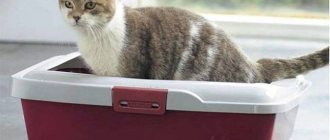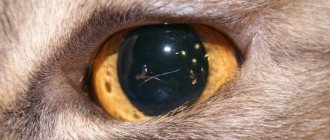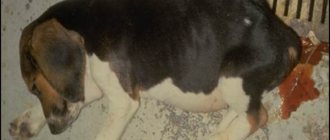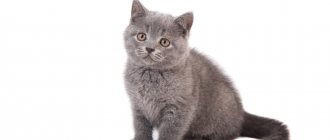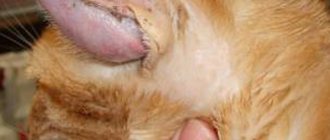Most cat owners will immediately become alert if they discover cat has bloody diarrhea. If ordinary diarrhea can also appear from simple errors in the diet, then blood in loose stool is a symptom of severe intestinal inflammation, in which the cells of the intestinal mucosa along with the capillaries peel off. With such a pathology, self-medication is dangerous and ineffective, since the tablets will not be absorbed by the inflamed intestines. The cat owner needs to know about the most common causes of bloody diarrhea in order to seek qualified veterinary help as soon as possible.
Why do loose, bloody stools appear?
Most often, bloody diarrhea in a cat occurs due to the following ailments:
- exacerbation of inflammation in the large intestine, which is diagnosed mainly in kittens;
- infectious colitis;
- viral infections, in particular panleukopenia;
- traumatic injuries in the rectum and anus;
- acute pancreatitis with destruction of the small intestinal mucosa;
- helminthic infestations;
- acute and chronic intoxication with poisons, household chemicals, poor-quality food, etc.;
- gastrointestinal tumors.
What is diarrhea
This is a symptom of various diseases in which disorders of the stomach/intestines are diagnosed. It appears as liquid frequent bowel movements, with the possible presence of various inclusions.
In many diseases, diarrhea (diarrhea) is a protective reaction of the body, helping it remove toxins and foreign harmful substances from the intestines.
Diarrhea often causes pain in kittens and is accompanied by vomiting, loss of appetite, and lethargy. Long-lasting and incessant, it can be dangerous not only to the health, but also to the life of the kitten’s fragile body.
With liquid bowel movements, dehydration develops - substances that are extremely important for the normal functioning of the entire body (calcium, sodium, potassium) are lost. This causes a serious imbalance in the functioning of the organs.
Severe dehydration can even lead to cardiac arrest.
Normally, in older kittens, the feces should be dark brown in color, shaped like short tubes. A healthy animal defecates 1-2 times a day, sometimes three times a day. Very young kittens may pass unformed, pasty, light brown feces.
This, in the absence of other pathological symptoms, is considered normal and is associated with feeding habits (the diet contains a large amount of mother's milk).
You can talk about diarrhea if the kitten goes to the potty too often. In this case, the feces are liquid or semi-liquid, containing mucus, blood, and other foreign inclusions.
Clinical picture
Bloody diarrhea in a cat, the causes of which lie in pathology of the internal organs, is very rarely the only manifestation of a painful condition. The main disease with liquid, bloody feces in the vast majority of cases occurs against the background of the appearance of digestive disorders in the form of dyspepsia, vomiting, and refusal to eat. Decreased appetite and insufficient feeding lead to sudden weight loss and a deterioration in the general condition of the pet, which becomes apathetic, lethargic and drowsy.
Cats suffering from loose stools with bloody streaks experience frequent urination and polydipsia (increased feeling of thirst) associated with it. Diarrhea with blood in a cat, the causes of which are directly related to infection of the animal’s intestines by pathogenic microorganisms, occurs against the background of an increase in general body temperature, sometimes severe intoxication and fever with convulsions.
What to do if your cat has bloody diarrhea? The following symptoms should be a signal to visit a veterinarian:
- You should see a doctor immediately if your cat has been feverish for several days, feels unwell, does not eat and is constantly vomiting;
- the animal must be shown to a specialist when there is a suspicion that the cat has been poisoned by toxic substances or rat poison;
- the reason for a visit to the veterinarian should be severe dehydration of the cat’s body, the animal’s unconscious state, convulsions or a change in the color of the mucous membranes;
- You should definitely show your veterinarian a cat with bloody diarrhea that has not been vaccinated or revaccinated on time.
Main predisposing factors
Let's look at the most typical and common causes in veterinary practice. First, “simple” digestive disorders. Contrary to popular belief, in some cases they can pose a serious danger to the health and even life of the animal.
In severe cases of these pathologies, food in the intestines practically ceases to be processed. There are a lot of reasons leading to this - from poisoning to liver damage (by the way, yellow diarrhea can happen), but the result is always the same. Damage to the epithelial layer of the intestines occurs, as a result of which a lot of mucus appears in the stool (detached epithelium), and bloody inclusions may appear in the stool.
Poisoning
Poisoning is especially dangerous. Moreover, kittens have the hardest time when salts of heavy metals and household chemicals enter their bodies. And bloody diarrhea in such situations is very “good.” Diarrhea at least shows that something is wrong with the animal, and it wouldn’t hurt to take it to the vet. In most cases, severe poisoning in kittens is not accompanied by diarrhea - the animal simply dies even before it develops. More often than not, your pet has severe stomach pain, which can be easily determined even with shallow palpation.
Foreign bodies in the digestive tract
Usually this term refers to various absolutely inedible objects that a curious kitten can use for other purposes. For example, there are frequent cases when young animals swallow pieces of bags, paper, and other debris. But in this situation, what is much sadder is the “concern” of some owners who give their pets fish and chicken bones, which is absolutely forbidden to do...
Remember that this is non-food waste; giving it to animals (any kind) is strictly prohibited!
The reason is, firstly, the meaninglessness of this activity. The nutritional value of any bones that have undergone heat treatment is close to zero. But even if the product has been deboned and has not been subjected to thermal influences, it is simply dangerous for the pet. The problem is that chicken bones easily split into long fragments, comparable in sharpness to a knife. Fish bones themselves are sharp and can easily pierce the thin walls of the digestive organs.
Remember! All these “delicacies” severely injure the intestines and stomach, which leads to the appearance of copious amounts of blood in the feces.
The diarrhea itself in these cases develops because the affected areas of the intestines are quickly contaminated with pathogenic and conditionally pathogenic microflora, an inflammatory process develops, which inevitably leads to digestive disorders and the occurrence of diarrhea.
The conclusion is simple - bones, no matter how appetizing they look, cannot be fed to cats! Such “savings” may well lead to the death of the animal. To help your pet brush its teeth and train its jaw muscles, buy special “bones” made from pressed veins. In addition, you can give older kittens small pork “mosleys” with leftover meat. They do not break into fragments and are safe for the health and life of your pets.
Injuries
This also (albeit indirectly) includes various injuries to internal organs. They are the result of strong impacts, collisions with vehicles and bicycles, animals falling from a height, etc. The danger of injuries (as well as “bone” diarrhea) lies in the high risk of internal bleeding, which can cause the animal to die in a few minutes.
If your kitten has an unfortunate fall or fight with an older kitten, after which he develops bloody diarrhea, immediately take him to the clinic. You can't do anything on your own.
Worm infestations
Oddly enough, many helminthic infestations are relatively mild; characteristic clinical signs may not be noticed (often they do not exist at all). In particular, blood in the stool is not a very characteristic symptom for these pathologies. Even among experienced breeders, there is a widespread belief that with helminthiasis, parasites necessarily appear in feces, but this is not at all true. Moreover, their presence in feces and vomit indicates very “severe” cases of helminthic infestations. So why can blood appear during diarrhea if the animal has worms?
This doesn't always happen. Bloody diarrhea is a consequence of a pet being infected with certain types of nematodes (parasitic roundworms). In particular, the appearance of bloody inclusions in feces is a characteristic sign of hookworm infection. This is the name for helminthiases caused by hookworms - small but very unpleasant parasitic worms. They differ from “standard” worms in that they feed not on semi-digested food masses in the animal’s intestines, but on pieces of mucous membranes and blood. If there are relatively few parasites, then there may not be any symptoms - the intestines regenerate quickly enough, little blood is released, and it has time to be digested.
But in cases where there are a lot of hookworms in the kitten’s intestines, everything is different. Worms constantly feed, which is why the intestinal mucosa is constantly injured. Accordingly, blood is released from the lesion sites. Cuts and wounds do not have time to heal, and “bloody” diarrhea with mucus and chronic anemia develop.
If these signs appear, the animal must be urgently shown to a veterinarian, since further delay will not end well.
If the pet does not die from dehydration, the “faithful companion” of diarrhea, then anemia and intoxication will definitely kill it. In addition, damaged mucous membranes are no longer a reliable barrier to pathogenic and conditionally pathogenic microflora. Bacteria can freely penetrate into the general bloodstream, resulting in bacteremia and sepsis. And these phenomena in the case of kittens are almost certainly fatal. So you definitely shouldn’t hesitate to visit the veterinary clinic.
Please note that after deworming, the kitten will not be able to recover “like magic”! And you don’t need to give him regular food right away. We will talk about the characteristics of proper feeding of sick and recovering animals a little later.
Inflammation of the paraanal glands
Perhaps one of the most “harmless” reasons for the appearance of blood in feces. Cats have special glands near the anus. They secrete a special secretion that helps lubricate the anus and facilitates the passage of feces through it. Sometimes (due to improper feeding, injury, infection) the glands become inflamed. An abscess develops and the affected part of the body begins to bleed. Accordingly, blood appears in the feces.
But how are diarrhea and inflammation of the paraanal glands related? It's quite simple. With diarrhea, the “back” regions of the kitten’s body are constantly wet, soiled with feces. Accordingly, the environment for the development of conditionally pathogenic and pathogenic microflora in such conditions is simply ideal. The likelihood of inflammation of the glands increases sharply. And you should not take this pathology lightly. Yes, this is not internal bleeding, and therefore your pet is not in danger of immediate death. But the long-term consequences are not encouraging.
For example, inflammation of the sinuses threatens the formation of internal abscesses located in the pelvic cavity. Moreover, their size can be very large - even in kittens there have been cases of growth to the size of an average tangerine. If such a neoplasm bursts, the animal is almost 100% likely to die from diffuse peritonitis. So, if bright red, fresh blood appears in the feces and severe pain is experienced by the kitten during defecation, the pet should be immediately taken to a veterinary clinic.
Is it possible to be treated at home?
What to do if a cat has bloody diarrhea, and how to help the animal at home? First of all, you should change the approach to feeding your pet and if you find bloody, loose stools, stop feeding the animal during the first day from the onset of the disease, even if the cat retains its appetite. At the same time, the furry patient cannot be limited in drinking, which must be in adequate quantities. Such actions will allow the cat to free its intestines from residual feces and reduce the manifestations of intoxication syndrome.
On the second day, the cat can be fed. It is best to give the animal half the usual amount of food.
If bloody bowel movements do not stop and stool does not return to normal, it is necessary to take the sick animal to the veterinarian to determine the causes of the pathological condition and prescribe drug therapy.
Nutrition
During treatment, it is important to follow a special diet that will help relieve the gastrointestinal tract.
In the first 12 hours, it is recommended not to feed the pet, but to offer or syringe only water or rehydration solutions. After the specified time, you can introduce boiled rice and boiled meat. Portions should be reduced by 2-3 times during the recovery of the digestive system.
If a cat or kitten is diarrhea due to enzyme deficiency, foods that are poorly digested should be excluded. Most often, milk and dairy products are excluded. During this period of time, it is recommended to include in the diet special food for cats with digestive tract problems. Rice water and an infusion of flax seeds, which have astringent properties, will also be useful.
To prepare the first one, you need to pour the cereal with water in a ratio of 1:7, bring to a boil and simmer under the lid for about 30-40 minutes. For flaxseed infusion, 1 tbsp is enough. Pour boiling water over the seeds and leave for 2-3 hours. Give your pet 1 tsp every hour.
Features of specialized treatment
Treatment of diseases that are accompanied by bloody diarrhea should be carried out by a qualified specialist. Treatment of the disease must be implemented as quickly as possible, otherwise the owner risks losing his pet.
Specialized treatment of bloody diarrhea in cats has several goals:
- determining the cause of a pathological symptom using modern laboratory and instrumental diagnostic methods;
- prescription of etiotropic therapy;
- symptomatic treatment of complications;
- competent rehabilitation of the animal.
The decisive factor when choosing treatment tactics for loose, bloody stools is the cause of the development of the underlying pathology that led to such consequences. If the process was provoked by pathogenic microorganisms, then the doctor decides to prescribe antibacterial therapy lasting from 14 to 21 days with a control stool test. Helminthic infestations are treated with anthelmintic drugs, and chronic colitis is treated with normalization of feeding and restoratives. Qualified treatment is effective in almost 90% of cases, and its results depend on the timely diagnosis of the disease, the correctness of therapeutic tactics and the individual characteristics of the sick cat’s body.
Prevention
If a cat is diarrhea with blood, it is recommended in the future to follow a diet and not give the pet dairy products and dishes from the human table. After a course of medicinal food, it is advisable to purchase canned food and pouches. Bowls must be kept clean to prevent bacteria from growing in them. Deworming should be carried out on time.
All information posted on the site is provided in accordance with the User Agreement and is not a direct instruction to action. We strongly recommend that before using any product, you must obtain a face-to-face consultation at an accredited veterinary clinic.
